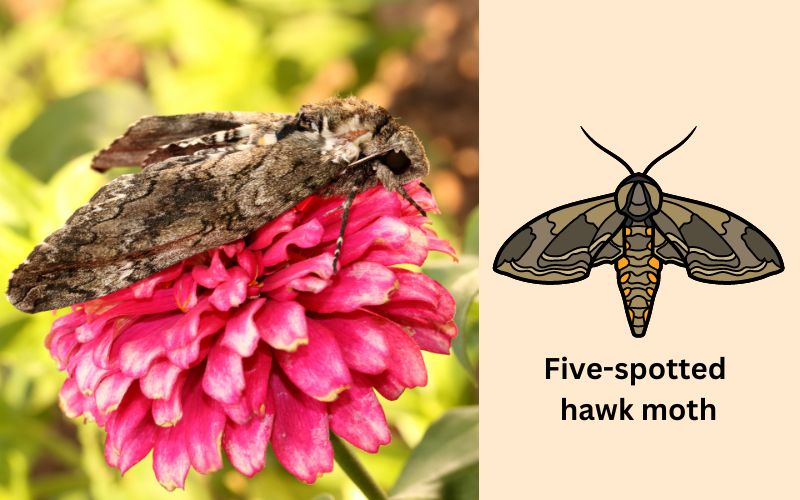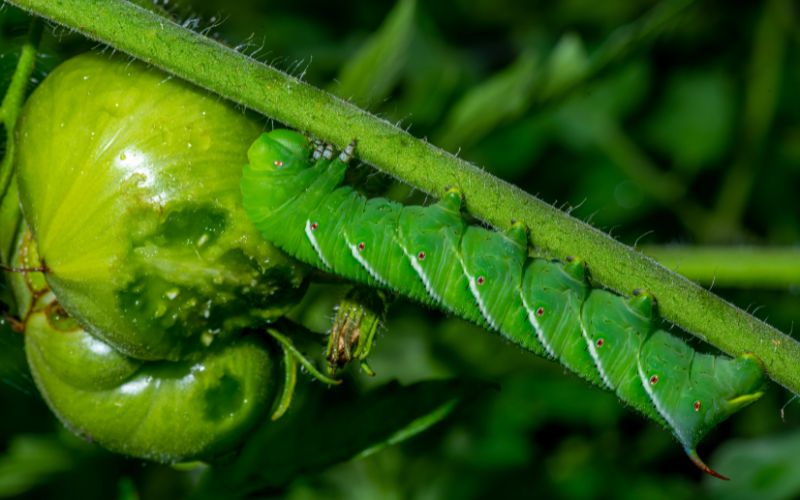If you’re a tomato gardener in Nothern America, you will likely have encountered the notorious tomato hornworm at some point. These voracious caterpillars can quickly defoliate and damage entire tomato plants if left unchecked.
In this blog post, we will delve into the world of tomato hornworms, find out how to identify them, their lifecycle, signs of infestation, and effective control methods. By arming yourself with knowledge and implementing proper management techniques, you can protect your tomato plants from these hungry intruders.
Identifying Tomato Hornworms
As their name suggests, tomato hornworms prefer tomato plants, they also feed on vegetable plants of the same family, including potato, eggplant, and pepper. Tomato hornworms are the larvae of the five-spotted hawk moth.

They are originally from North America and are common in warmer areas from southern Canada to northern Mexico, while they may also be found in Australia and other locations to which they have been accidentally introduced.
Tomato hornworms are large, bright green caterpillars that can grow up to 4 inches long. They have smooth bodies with distinct white diagonal stripes along their sides and a prominent horn-like appendage on their back end. Their camouflaged coloring allows them to blend in seamlessly with tomato foliage, making them hard to spot.

Tomato hornworms (Manduca quinquemaculata) look very similar to tobacco hornworms (Manduca sexta), which are closely related to and also feed on tomato plants. Tobacco hornworms are the larvae of the Carolina sphinx moth.

Signs of Infestation
The presence of tomato hornworms can be detected through various signs. Look out for chewed leaves, missing foliage, or stems. Tomato hornworms will also nibble on tomatoes.
[Image: Damage done by the tomato hornworm]

Another sign is frass or caterpillar droppings, which typically resemble small, cylindrical pellets or granules that are green to brown in color, indicating the feeding activity of the caterpillars.
Lifecycle of Tomato Hornworms
Tomato hornworms undergo a complete metamorphosis, starting as eggs before hatching into caterpillars. Adult five-spotted hawk moths lay tiny, green, round eggs on the undersides of tomato leaves.
Once hatched, the caterpillars begin feeding voraciously on the foliage and their numbers can increase within weeks. They will eventually pupate in the soil, emerging as adult moths to continue the cycle.

How to get rid of Tomato Hornworms
To protect your tomato plants from tomato hornworms, here are some effective control methods:
- Handpicking: Regularly inspect your tomato plants for any signs of hornworm infestation. Wear gloves and manually remove the caterpillars from the plants, dropping them into a bucket of soapy water will prevent their return.
- Natural Predators: Encourage beneficial insects and animals that prey on tomato hornworms.
The braconid wasp (Cotesia congregata) is a parasitoid that lays its eggs inside the body of tomato hornworms. The female wasp uses their long ovipositor to inject eggs directly into the caterpillar’s skin. Once the wasp eggs hatch, the larvae feed on the internal tissues of the caterpillar, eventually causing the death of the caterpillar.
The braconid wasp larvae complete their development inside the hornworm caterpillar, and when ready to pupate, they emerge from the caterpillar’s body. The emerging larvae form small white cocoons that can often be seen attached to the caterpillar’s skin. The cocoons serve as a protective casing for the developing wasps.

Attracting birds, such as hummingbirds and certain songbirds, can also help keep the hornworm numbers in check.
- Crop Rotation: Practice crop rotation by planting tomatoes in a different location each year. This will disrupt the hornworms’ life cycle and reduce the likelihood of re-infestation.
Read more on crop rotation and why it’s important
- Protective Barriers: Covering your tomato plants with floating row covers or netting can physically prevent adult moths from laying their eggs on the foliage, reducing the chance of infestation.
- Organic Insecticides: If infestations are severe or other methods have not provided sufficient control, consider using organic insecticides containing Bacillus thuringiensis (Bt). Bt is a naturally occurring bacterium that specifically targets caterpillars but is safe for beneficial insects.
How to protect your tomato plants from tomato hornworms
To safeguard your tomato harvest from potential damage, it is essential to remain vigilant throughout the growing season. Regularly inspect your plants, especially the undersides of leaves where hornworm eggs are usually laid. Acting promptly as you detect any signs of infestation can prevent the caterpillars from causing extensive damage.
Maintaining a healthy garden is key to effectively managing tomato hornworms and other pests. Encouraging biodiversity, planting companion plants that repel pests, and properly caring for your tomato plants will help create a balanced environment that discourages hornworms from establishing in your garden.

